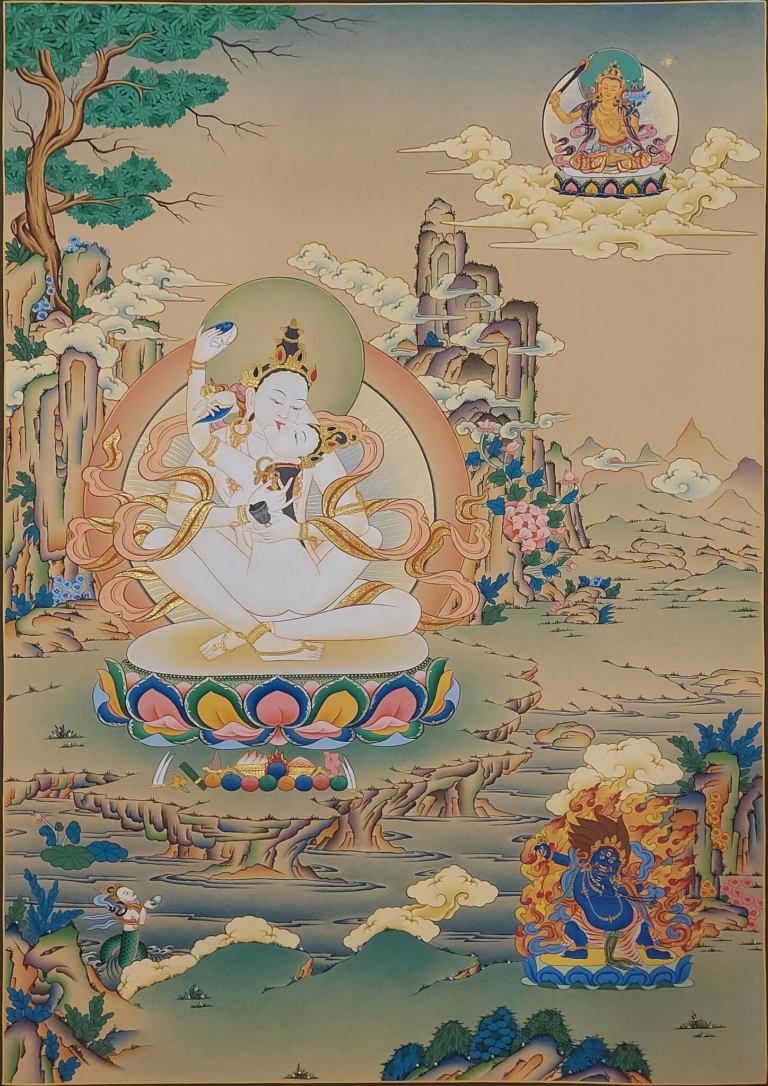Description
Karma Gadri Art in Vajrasattva is buddhist Handmade Thangka with dimension 76*53 cm. It is handpainted on cotton canvas in Kathmandu, Nepal.
Vajrasattva is depicted at the center of painting. Manjushri is presented on top of Vajrasattva in the painting. Vajrapani is presented on the bottom of the Vajrasattva in the painting.
| Weight | 100 Grams |
| Size | 76 x 53 cm |
| Material | Cotton Canvas and Mineral Color |
Mantra of Vajrasattva
The mantra of Vajrasattva is Om Vajrasattva Hum.
Iconography of Vajrasattva
Vajrasattva is pure white in color and is sometimes known as the Prince of Purity. His name means “Adamantine Being”, or more poetically “Embodying Reality”.
He is a member of the Vajra family of Aksobhya which also includes Vajrapani. He is depicted as a young man in the prime of life, with all the silks and jewels of a wealthy prince.
In his right hand, he delicately balances a vajra at his heart. In his left hand, he holds a bell at his waist. The vajra represents Reality, and Compassion; while the bell represents Wisdom.
Vajrasattva is said to have been originated from the seed syllable Hum and is generally invoked for removal of obscuration of Kleshavarana and Jneya Avarana.
His hundred syllable mantra is very efficacious in purifying our defilements through confession practice. It is said if confession is done with the four opponent powers, then non-virtuous actions or obscurations will be purified.
The first opponent power is the force of reliance. This means looking upon the visualized image of Vajrasattva as the embodiment of one refuge. The second opponent power is the sincere regret for the non-virtuous action done by oneself.
The third opponent’s power is desisting from evil deeds. The fourth opponent power is to apply the power of good deeds; and especially regarding this case, practicing the meditation and recitation of Vajrasattva without parting from Bodhicitta while remaining in the state of emptiness.
Vajrasattva is a very popular tutelary deity for Nepalese Vajracharya. He is worshipped very often by Nepalese Buddhists through the Guru Mandala ritual.
Iconography of Manjushree
Manjushri is presented on top of Vajrasattva in the painting. Manjushree is the Bodhisattva who holds the flaming sword of enlightenment, by his left hand in a warning hand gesture in the left hand representing his realization of wisdom to cut through ignorance & wrong view. His right hand depicted in teaching holds the stem of a Blue Lotus flower upon which rests the Book (Pustaka) of Perfection of Transcendental Wisdom.
Mantra of Manjushree
The mantra of Manjushree is Om A Ra Pa Ca Na Dhih.
Iconography of Vajrapani
Vajrapani is presented on the bottom of the Vajrasattva in the painting. Vajrapaṇi is one of the earliest bodhisattvas of Mahayana Buddhism. He is the protector and guide of the Buddha and rose to symbolize the Buddha’s power.
Vajrapani is pictured dancing wildly within a halo of flames which represents transformation. He holds a vajra (thunderbolt) in his right hand which emphasizes the power to cut through the darkness of delusion. Vajrapani looks wrathful, but as a representation of the enlightened mind. He is completely free from hatred.
Mantra of Vajrapani
The mantra of Vajrapani is om vajrapani hum phat.
































Reviews
There are no reviews yet.